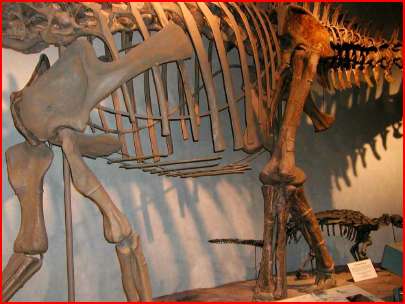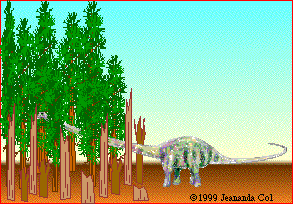Quick Info
- Plant eater
- Small head with spatulate or pencil-shaped teeth
- Walked on four legs
- Among the longest land animals!
All About the Diplodocus
Anatomy
Diplodocus was a long-necked, whip-tailed giant, measuring about 90 feet (27 m) long with a 26 foot (8 m) long neck and a 45 foot (14 m) long tail, but its head was less than 2 feet long. It was among the longest land animals ever. Its nostrils were at the top of its head and it had peg-like teeth, but only in the front of the jaws. Its front legs were shorter than its back legs, and all had elephant-like, five-toed feet. One toe on each foot had a thumb claw, probably for protection. A fossilized Diplodocus skin impression reveals that it had a row of spines running down its back.

Photo of Diplodocus gastralia and other bones courtesy of Jim Puckett, using an Olympus 3040 digital camera - taken in the Dinosaur Hall of “Prehistoric Journey” at the Denver Museum of Nature and Science.
Diplodocus was more lightly built than the other giant sauropods, and may have weighed only about 10-20 tons. Its backbone had extra bones underneath it, which had bony protrusions running both forwards and backwards (anvil shaped), a “double beam”, probably for support and extra mobility of its neck and tail. It may have used its whip-like tail for protection. A recent Diplodocus skin impression was found, showing a row of spines running down the back.
It has been determined that Diplodocus (and the other diplodocid saropods, like Apatosaurus) could not hold their necks over about 17 feet (5.4 m) off the ground (Parrish and Stevens,1999).
Gastralia (hanging belly ribs) are thin, fragile ribs that helped support and protect the internal organs (like the lungs) in the middle area of the body. These ribs were not attached to the backbone; they were attached to the skin in the belly area.
Diet and Teeth
Diplodocus was an herbivore (it ate only plants). It must have eaten a tremendous amount of plant material each day to sustain itself. It swallowed leaves whole, without chewing them, and may have swallowed gastroliths (stones that remained in its stomach) to help digest this tough plant material. It had blunt teeth, useful for stripping foliage.
Its main food was probably conifers, which were the dominant plant when the large sauropods lived. Secondary food sources may have included gingkos, seed ferns, cycads, bennettitaleans, ferns, club mosses, and horsetails.
Why was its neck so long?
 Diplodocus held its neck more-or-less horizontally (parallel to the ground). The long neck may have been used to poke into forests to get foliage that was otherwise unavailable to the huge, lumbering varieties of sauropods who could not venture into forests because of their size. Alternatively, the long neck may have enabled this sauropod to eat soft pteridophytes (horsetails, club mosses, and ferns). These soft-leaved plants live in wet areas, where sauropods couldn’t venture, but perhaps the sauropod could stand on firm ground and browse in wetlands.
Diplodocus held its neck more-or-less horizontally (parallel to the ground). The long neck may have been used to poke into forests to get foliage that was otherwise unavailable to the huge, lumbering varieties of sauropods who could not venture into forests because of their size. Alternatively, the long neck may have enabled this sauropod to eat soft pteridophytes (horsetails, club mosses, and ferns). These soft-leaved plants live in wet areas, where sauropods couldn’t venture, but perhaps the sauropod could stand on firm ground and browse in wetlands.
Behavior
Diplodocus may have travelled in herds, migrating when the local food supply was depleted. Diplodocus probably hatched from eggs, like other sauropods. Sauropod eggs have been found in a linear pattern and not in nests; presumably the eggs were laid as the animal was walking. It is thought that sauropods did not take care of their eggs. Sauropod life spans may have been on the order of 100 years.
Intelligence
It used to be thought that the sauropods (like Diplodocus, Brachiosaurus and Apatosaurus) and Stegosaurus had a second brain. Paleontologists now think that what they thought was a second brain was just an enlargement in the spinal cord in the hip area. This enlargement was larger than the animal’s tiny brain.
Diplodocus was a sauropod, whose intelligence (as measured by its relative brain to body weight, or EQ) was the among the lowest of the dinosaurs.
Locomotion
Diplodocus moved slowly on four column-like legs (as determined from fossilized tracks and its leg length and estimated mass).
When Diplodocus Lived
Diplodocus lived in the late Jurassic Period, from 155-145 million years ago. The late Jurassic was the time of the enormous sauropods, including Camarasaurus, Apatosaurus, and Brachiosaurus. Also present were Stegosaurus, Tuojiangosaurus, Allosaurus, Supersaurus, Coelurosaur, and many others.
Fossils and Name
The first Diplodocus fossil was found by Earl Douglass and Samuel W. Williston in 1877 and was named by paleontologist Othniel C. Marsh in 1878. Many Diplodocus fossils have been found in the Rocky Mountains of the western USA (in Colorado, Montana, Utah, and Wyoming). Diplodocus means “Double-beamed.”
Classification
Diplodocus was a huge herbivorous dinosaur that belonged to the:
- Kingdom Animalia (animals)
- Phylum Chordata (having a hollow nerve chord ending in a brain)
- Class Archosauria (diapsids with socket-set teeth, etc.)
- Order Saurischia - lizard-hipped dinosaurs, the ancestors of birds
- Sauropodomorph - long-necked, long-tailed plant-eaters who walked on four legs
- Suborder Sauropoda (sauropods) - very large herbivores
- Neosauropoda - advanced sauropods
- Family Diplodocidae - whip-tailed, peg-toothed sauropods with high spines on the vertebrae. These included Amargasaurus, Apatosaurus, Supersauurs, Barosaurus, Seismosaurus, and others
- Genus Diplodocus
- Species D. longus (the type species: Marsh, 1878), D. carnegiei (Hatcher, 1901), D. hayi (Holland, 1924)
Activities and Printouts
- Print out a K-3 level Diplodocus information sheet to color!
- A Diplodocus fact sheet or a printable version.
- A first-grade level Diplodocus subtraction activity print-out.
Other Dinosaur Info Sheets
Just click on an animal’s name to go to that information sheet. If the dinosaur you’re interested in isn’t here, check the Dinosaur Dictionary or the list of Dinosaur Genera.
How to write a great dinosaur report.
Names with an asterisk (*) were not dinosaurs.
